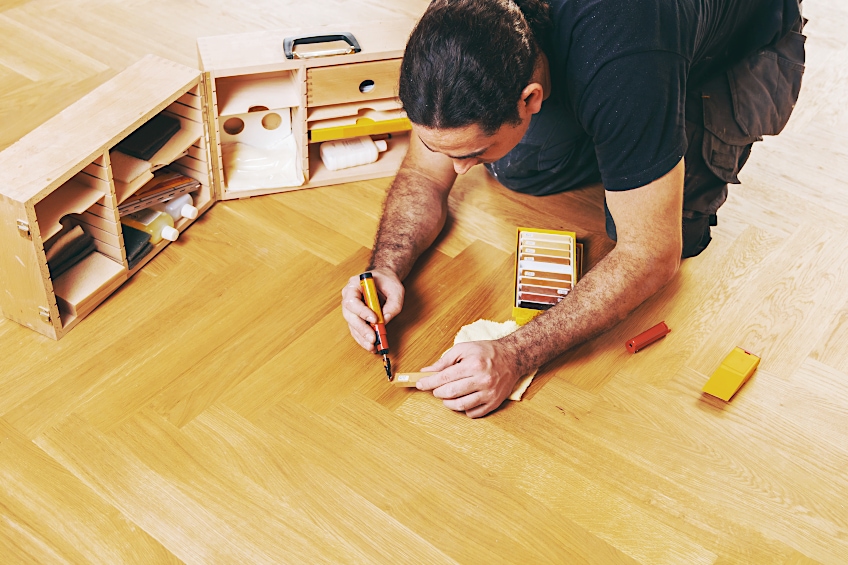Imagine this: you’re settling into a cozy evening, a mug of warm tea in hand, but a symphony of creaks and groans emanates from beneath your feet. It’s a common annoyance, a familiar frustration for countless homeowners. The culprit? Your beloved wood floor, a testament to time and wear, has developed a telltale creakiness. But despair not! This guide will empower you with the knowledge to silence those noisy boards and reclaim the peace and tranquility of your home.

Image: s3.amazonaws.com
Creaking wood floors, though seemingly minor, can significantly impact your home’s comfort and ambiance. They disrupt quiet moments, amplify noise, and sometimes even indicate underlying structural problems. This article delves into the root causes of creaky wood floors, offering a comprehensive blueprint for tackling them. We’ll explore various solutions, from temporary fixes to long-lasting repairs, equipping you with the tools and techniques to banish those annoying sounds forever.
Understanding the Cause of Creaking
The genesis of a creaking wood floor lies in the movement of individual floorboards, rubbing against joists beneath or against each other. This friction is often the culprit behind the familiar creaks and groans. Several factors contribute to this movement:
- Age and Wear: As wood floors age, they tend to dry out, shrink, and become more susceptible to movement.
- Shifting Foundation: A settling foundation or shifting soil can cause uneven pressure on the floorboards, leading to creaking.
- Changes in Humidity: Wood is hygroscopic, meaning it absorbs and releases moisture from the air. Fluctuations in humidity can cause wood to expand and contract, leading to creaking.
- Loose Fasteners: Over time, nails and screws holding the floorboards to the joists can loosen, causing the boards to shift and creak.
- Traffic Patterns: High-traffic areas, like hallways and doorways, experience more movement, placing added stress on the floorboards.
DIY Solutions for Stopping Creaks
Before launching into major structural work, there are a handful of quick fixes you can try to silence those annoying sounds. Let’s explore these solutions:
1. Lubricate the Floorboards
A common culprit behind creaking is friction between the floorboards. Introducing a lubricant like talcum powder, baby powder, or dry graphite can alleviate friction and quiet the creaking. Simply sprinkle the powder into the cracks between the floorboards and sweep it in.

Image: resin-expert.com
2. Tighten Loose Screws or Nails
Often, a creaky floorboard can be remedied by tightening loose screws or nails. Using a screwdriver or nail gun, carefully assess the floorboards and re-secure any loose fasteners. This is most effective when dealing with floorboards that are slightly loose but haven’t completely shifted.
3. Apply Wood Filler or Glue
For smaller gaps or cracks between floorboards, wood filler or wood glue can be effective solutions. Apply the filler or glue with a putty knife, ensuring it’s level with the floor surface. Once dried, sand the area smooth for a seamless finish.
4. Use Floorboard Clips
Another simple solution for fixing loose floorboards is the use of floorboard clips. These clips are designed to clamp onto the underside of the floorboards and securely attach them to the joists. Simply insert the clips into the appropriate spot and tighten them to eliminate the creaking.
Addressing More Serious Creaking
If temporary fixes don’t yield lasting results, it’s time to tackle the problem more decisively. This might involve:
1. Reinforcing the Floor Joists
If the floor joists are weak or spaced too far apart, they may not be able to adequately support the weight of the floorboards. Consider adding additional joists or reinforcing existing ones to strengthen the subfloor structure.
2. Replacing Damaged Floorboards
If a floorboard is severely damaged, it’s best to replace it entirely. This involves carefully removing the damaged board, installing a new one, and securing it to the joists with screws or nails.
3. Installing a Subfloor
In cases of severe creaking, installing a subfloor can significantly reduce noise and improve the overall stability of the floor. A subfloor is a layer of plywood or OSB installed over the existing joists, providing additional support and a more solid platform for the floorboards.
Seeking Professional Expertise
For more challenging situations, don’t hesitate to consult a professional contractor. They may be able to identify underlying structural issues, provide tailored solutions, and ensure the repair is carried out correctly. Seeking professional assistance is especially crucial when dealing with old homes or potential foundation problems.
Maintaining the Silence
Once you’ve tackled the creaking, it’s essential to maintain the silence. Here are some preventive measures:
- Control Humidity: Humidity fluctuations play a significant role in wood movement. Try to maintain a consistent humidity level within your home by using a dehumidifier during humid seasons or a humidifier during dry periods.
- Reduce Foot Traffic: High-traffic areas see more wear and tear. Consider using area rugs or mats to cushion high-traffic zones and minimize stress on the floorboards.
- Regular Inspections: Periodically inspect your floor for any signs of movement or loose fasteners. Early detection can prevent minor issues from escalating into major problems.
How To Stop A Creaking Wood Floor
Conclusion
Silencing a creaking wood floor is a rewarding endeavor that improves your home’s comfort and tranquility. Whether you choose quick fixes or more extensive repairs, remember to approach each task with patience and attention to detail. Armed with the knowledge and techniques presented in this guide, you can effectively address the creaking and enjoy a peaceful, noise-free home. So, grab your tools and take pride in restoring the quiet charm of your wood floors.






